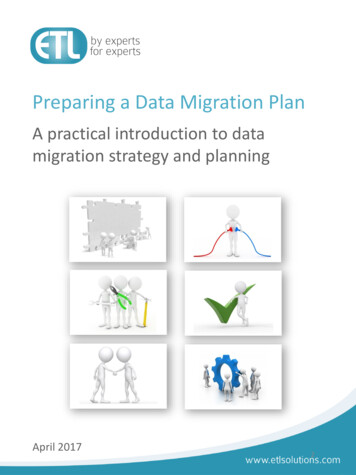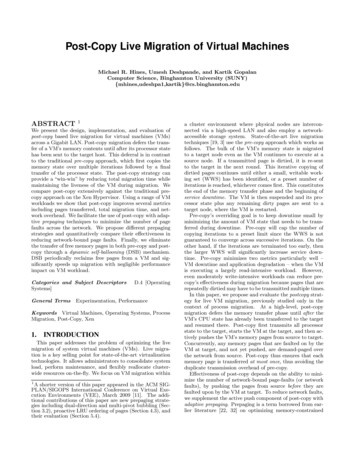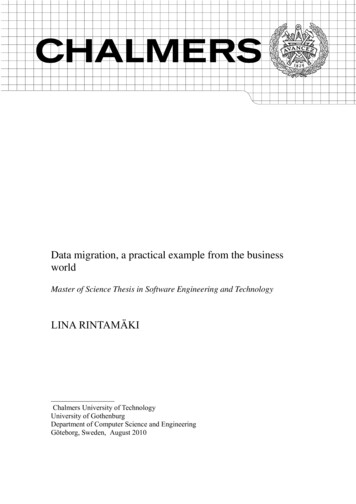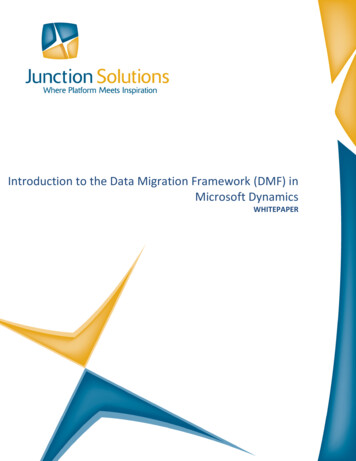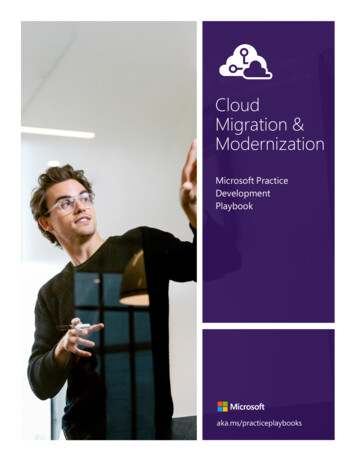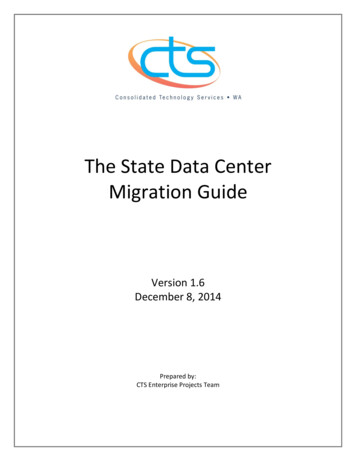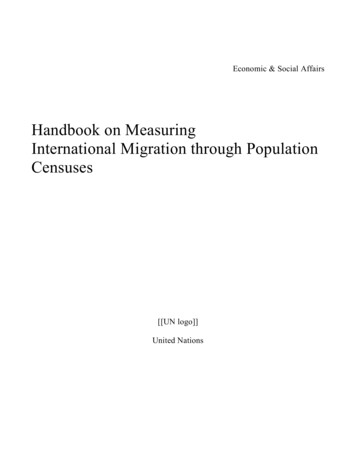
Transcription
Economic & Social AffairsHandbook on MeasuringInternational Migration through PopulationCensuses[[UN logo]]United Nations
ST/ESA/STAT/SER.F/115Department of Economic and Social AffairsStatistics DivisionSeries F No. 115Handbook on MeasuringInternational Migration throughPopulation CensusesUnited NationsNew York, 2020
Department of Economic and Social AffairsThe Department of Economic and Social Affairs of the United Nations is a vital interface between globalpolicies in the economic, social and environmental spheres and national action. The Department works in threemain interlinked areas: (i) it compiles, generates and analyses a wide range of economic, social andenvironmental data and information on which United Nations Member States draw to review commonproblems and to take stock of policy options; (ii) it facilitates the negotiations of Member States in manyintergovernmental bodies on joint courses of action to address ongoing or emerging global challenges; and (iii)it advises interested Governments on the ways and means of translating policy frameworks developed inUnited Nations conferences and summits into programmes at the country level and, through technicalassistance, helps build national capacities.NoteThe designations employed and the presentation of the material in the present publication do not imply theexpression of any opinion whatsoever on the part of the United Nations concerning the legal status of anycountry or of its authorities or the delimitations of its frontiers. The term “country” as used in this publicationalso refers, as appropriate, to territories or areas. The designations of country groups, or developed ordeveloping regions in the publication are intended solely for statistical or analytical convenience and do notnecessarily express a judgment about the stage reached by a particular country, territory or area in thedevelopment process. Mention of the names of firms and commercial products does not imply the endorsementof the United Nations. The symbols of United Nations documents are composed of capital letters and numbers.Mention of such a symbol indicates a reference to a United Nations document.United Nations publicationSales No. E.Copyright United Nations, 2020All rights reservedST/ESA/STAT/SER.F/115ISBNeISBN
ContentsAcknowledgementsChapter I: Introduction – Need for a handbook on international migration .2A. Calls for better statistics on international migration . 2B. Purpose and scope of the present Handbook . 4C. Organization of the Handbook . 5Chapter II: Concepts and definitions related to international migration .7A. Concepts and definitions . 71. Definition of the term “international migrant”. 72. Short-term international migrant: a misnomer . 113. Use of the term “immigrant” for statistical and legal or administrative purposes . 11B. International migrants: flows versus stocks. 121. Flows of international migrants . 122. Population stocks related to international migration . 19Chapter III: Sources of data for measuring international migration .25A. Major sources of data on international migration. 251. Population censuses . 252. Household sample surveys . 273. Administrative registers. 28B. Additional sources of data on international migration . 301. Border collection . 302. Other administrative sources . 31Chapter IV: Key information and measurements .33A. Defining characteristics of immigrants and emigrants . 331. Defining the term “immigrant” . 332. Defining the term “emigrant”. 36B. Distinguishing characteristics. 381. Country of birth . 382. Country of citizenship. 383. Acquisition of citizenship . 394. Reason for admission of immigrating foreigners into a country . 395. Status of emigrating foreigners before leaving a country . 396. Departing citizen’s purpose for emigrating. 397. Immigrating citizen’s purpose for staying abroad . 40
ii T a b l e o f C o n t e n t s8. Country of previous or next residence. 409. Country of birth of parents . 40C. Descriptive characteristics . 41Chapter V: Important aspects of population census planning and design in measuring internationalmigration .42A. Introduction . 42B. Census planning and design. 431. Type of population count . 432. Use of sampling . 483. Communication and publicity campaigns . 494. Training of enumerators . 495. Confidentiality. 506. Topics for inclusion . 507. Formulation of questions . 518. Use of pre-coded response categories . 529. Provision of questionnaire in different languages . 5210. Enumeration methods . 5211. Enumerating people in unconventional living situations . 5312. Coverage and response . 5413. Processing and dissemination of data . 54Chapter VI: Collecting data on population stocks related to immigration .56A. Who is eligible to be counted in the census? . 56B. Population stocks related to immigration . 571. Foreign-born persons . 592. Foreigners. 663. Returning migrants . 734. Second-generation migrants. 78C. Other census topics relevant to immigration . 79D. Proposed questions for use in collecting data related to immigrant stock . 801. Country of birth (for foreign-born persons) . 802. Country of citizenship (for foreigners) . 813. Residence abroad (for returning migrants) . 824. Country of birth of parents (for second-generation migrants) . 835. Year or period of arrival in the country (for foreign-born persons or returning migrants). 836. Main reason for migration. 84Chapter VII: Challenges in measuring emigration .84A. Issues associated with measuring emigration in population censuses . 84
T a b l e o f C o n t e n t s iiiB. Collecting information on emigrants through an emigration module. 851. Current practices . 852. How good are data obtained from emigration modules? . 93C. Indirect estimation of emigrant stock from a population census . 94D. Using immigration data from receiving countries to estimate emigration . 95E. Proposed questions to use in collecting emigrant-related data . 971. Identification . 972. Year of departure . 993. Demographic and social characteristics . 994. Country of emigration . 1005. Main reason for emigration . 1006. Residence of living children. 100Chapter VIII: Estimating recent migration and net internationalmigration from population censuses . 102A. Indications of recent international migration. 1021. Use of data on place of residence at a specified time in the past . 1022. Use of the question on duration of residence and place of previous residence. 105B. Proposed questions for use in collecting data related to recent international migration1061. Place of residence one year ago . 1062. Place of residence five years ago . 106C. Methods for estimating net international migration from two censuses . 1071. Intercensal component method . 1072. Intercensal cohort component method. 1093. Intercensal component method for estimating net international migrationof foreign-born population . 110Chapter IX: Statistics, tabulations and indicators related to international migration that are obtainablefrom a census. 112A. Proposed statistics and tabulations related to immigrant stocks . 1121. Statistics and indicators . 1132. Suggested tabulations . 117B. Proposed statistics and tabulations related to recent migration . 1191. Statistics . 1192. Suggested tabulationsC. Proposed statistics and tabulations related to emigration . 1211. Statistics and indicators . 1212. Suggested tabulations . 123D. Proposed statistics and tabulations related to net international migration . 124
iv T a b l e o f C o n t e n t s1. Statistics and indicators2. Suggested tabulationsE. Degree of subnational spatial detail. 124F. Dissemination strategies . 124Chapter X: Using international migration data from the census together with data from other sources126A. Introduction . 126B. Issues to be considered when using other sources of data together with the census 1261. Alignment of concepts and definitions . 1262. Establishing a mechanism for cooperation among government agencies. 127C. Other sources of data on international migration for use with the census . 1271. Border control . 1272. Sample surveys . 1293. Population registers and other administrative sources. 130D. Special categories of international migrants . 1311. International labour migration2. Refugees and asylum seekersE. Conclusion . 137Annex: Methods for estimating net international migration from population censuses . 138A. Intercensal component method . 138B. Intercensal cohort component method . 140References. 166
T a b l e o f C o n t e n t s vTables2.1 Categories of inflows and outflows by usual residence and citizenship2.2 Taxonomy of international migrants according to entry and exit status, as established by the receiving State2.3 Framework for population stocks related to immigration2.4 Extended framework for identifying the stock of persons with foreign-born parents2.5 Framework for identifying the stock of citizens living abroad6.1 Topics that provide the required data on four policy-relevant population stocks9.1 Numerator, denominator and source tabulations for statistics and indicators 1 to 149.2 Numerator, denominator, comparison variable or category, and source tabulation for indicators 15 to 229.3 Data item and source tabulations for statistics types 1 to 49.4 Numerator, denominator and source table for statistics and indicators 1 to 6A.1 Canada: estimating total net migration, 1976–2001A.2 Australia: estimating the female population for the year 2011 using the survival ratios for the period 2005–2010A.3 Australia: estimating the female and male populations aged 0–4 for the year 2011A.4 Australia: estimating net international female migration in the period 2006–2011A.5 Australia: estimating net international male migration in the period 2006–2011A.6 Mexico: estimating the female population for the year 2005 using the survival ratios for the period 2000–2005A.7 Mexico: estimating the female and male populations aged 0–4 for the year 2005A.8 Mexico: estimating net female international migration, 2000–2005A.9 Mexico: estimating net male international migration, 2000–2005A.10 South Africa: estimating the female population for the year 2011 using the survival ratios for the period 2001–2006A.11 South Africa: estimating the female and male populations aged 0–4 for the year 2006A.12 South Africa: estimating the female and male populations aged 0–4 for the year 2011A.13 South Africa: estimating net international female migration, 2001–2011A.14 South Africa: estimating net international male migration, 2001–2011Figures
vi T a b l e o f C o n t e n t s6.1 Usual resident population versus population present approach10.1 Conceptual framework for measuring international migrant workersA.1 Australia: estimated net international migration, 2006–2011A.2 Mexico: estimates of net international migration by age and sex, 2000–2005A.3 Mexico: population by sex and single years of age, 2000 censusA.4 Mexico: population by sex and single years of age, 2005 censusA.5 South Africa: estimates of net international migration by age and sex, 2001–2011Boxes2.1 Description of the categories of immigrating foreigners included in the taxonomy of international migrants5.1 Groups of persons that are either included in or excluded from the usual resident population5.2 Utilization by countries of the usual resident population, population present and legal or permanent addressapproaches in the 2010 round of population and housing censuses6.1 Inclusion or non-inclusion of a question on place or country of birth in national censuses during the 2010 round ofpopulation censuses6.2 Is a question on country of citizenship asked in national censuses?6.3 Is a question on place of birth of parents included in national censuses?8.1 Is a question on place of usual residence at a specified time in the past included in national censuses?
1AcknowledgementsThe Handbook on Measuring International Migration through Population Censuses was prepared by the StatisticsDivision of the Department of Economic and Social Affairs of the United Nations. The publication is the outcome ofcollective efforts involving a wide range of contributors worldwide.Special gratitude is extended to Grace Bediako, who was responsible for the project’s conceptualization. Initial draftswere prepared by Graeme Hugo and Michel Poulain, consultants to the Statistics Division. The drafting process wasoverseen by Erlinda Go, who was also the lead author for several chapters of the Handbook. The following staff membersin the Demographic and Social Statistics Branch of the Division conducted research and drafted individual chapters:Haoyi Chen, Meryem Demirci and Keiko Osaki-Tomita, with the support of Andrew Smith and Mekdelawit Bekele.The Handbook was produced under the direction of Keiko Osaki-Tomita, Chief of the Demographic and Social StatisticsBranch.The Handbook was reviewed by the following experts, who provided substantive advice: Ann Singleton, BristolUniversity; Piotr Juchno, Eurostat; Mustafa Hakki Ozel, Department of Statistics, International Labour Organization;Frank Lazko, Global Migration Data Analysis Centre, International Organization for Migration; Vebjørn Aalandslid,Statistics Norway; Hyungseog Kim and Sabrina Juran, United Nations Population Fund; Bela Hovy, Population Division,Department of Economic and Social Affairs, United Nations; and Margaret Mbogoni, Statistics Division.Appreciation is also extended to members of the Expert Group on Migration Statistics who provided comments on theset of questionnaire modules covered in the Handbook.
T a b l e o f C o n t e n t s 2Chapter IIntroduction: Need for a handbook on international migration statisticsA. Calls for better statistics on international migration1.The formulation of sound policies demands solid data and the adoption of those data for use in conducting balancedresearch. The international community has been concerned for some time, however, by the gaps in the data on internationalmigration for evidenced-based decision-making. Governments have been urged on various occasions to regularly collect, compileand disseminate information in an internationally comparable manner on the cross-border movements of people and their situationin host societies. However, no satisfactory improvement has been observed to date with regard to the availability andstandardization of international migration statistics.2.Calls for improvement in international migration statistics go as far back as 1891, when the International Statistical Instituteat its congress held in Vienna discussed the coordination of international migration statistics and emphasized the importance ofestablishing a uniform definition of the term “international migrant” (Kraly and Gnanasekaran, 1987). During the early decades of thetwentieth century, the issue of internationally comparable migration statistics was taken up repeatedly at the conferences organizedby international organizations, especially the International Labour Office, which was established to help secure social justice forworkers, including migrant workers (ibid.). Often, the discussions at those conferences also focused on methods of collecting andcompiling emigration and immigration statistics.3.The mass displacement of people during and after the Second World War and the post-war reconstruction of Europe, whichinvolved large numbers of migrant workers, caused the international community to realize that migration statistics continued to befragmented and that reliable estimates with respect to the patterns and trends of migration were still largely lacking at both regionaland global levels. Early activities of the United Nations regarding international migration statistics focused on documentation andanalysis of statistical practices (Kraly and Gnanasekaran, 1987). In 1948, following the establishment of the United Nations, theEconomic and Social Council, at its seventh session, considered the issue of improving international migration statistics.4.In the publication entitled International Migration Statistics, issued in 1953, the United Nations proposed a new set ofstatistical standards with an explicit conceptualization of the demographic importance of migration, thereby addressing the criticismthat previous standards had been preoccupied with the manpower-related aspects of the migration process. The 1953recommendations, which elaborated on the subject of collection of information on all arrivals in and departures from a given country,and proposed the standardization of the definition of “permanent immigrant” on the basis of intended duration of stay, served as anorganizing framework for much of the subsequent documentation of international migration. However, the lack of adherence to thoserecommendations by countries – with, as a result, little evidence of an improvement in migration statistics – prompted the call forrevision of the recommendation (Simmons, 1987). By then, it was also well acknowledged that the concept of residence had been a“complicating factor” with regard to the development of a satisfactory definition of the term “migrant” for statistical purposes (UnitedNations, 1980, para. 21).5.In 1976, the United Nations developed new guidelines on international migration statistics, entitled Recommendations onStatistics of International Migration (United Nations, 1980). The salient features of the 1976 recommendations were their conceptualconsistency with other statistical systems, notably international tourism statistics; the identification of a number of additionalcategories of international population movements; and a large set of model tabulations, which subsequently became a target ofcriticism for being overly complex (Kraly and Gnanasekaran, 1987; Simmons, 1987). In the spirit of the 1976 recommendations, theUnited Nations also scaled up data-collection efforts, as attested in the publication of Demographic Yearbook 1977 (United Nations,1978), which was the first issue to feature international migration statistics as its special topic. However, persistent slow improvementin international migration statistics caused the United Nations Statistical Commission, at its twenty-seventh session in 1993, to requestthe Statistics Division (then called the Statistical Division) to initiate work on the review of the 1976 recommendations (UnitedNations, Economic and Social Council, 1993, paras. 128 and 129 (d)), which led eventually to the first revision of the
Introduction 3recommendations on statistics of international migration. It became apparent that while there had been growing recognition on thepart of the international community that international migration was an issue of global concern, countries continued to gather data oninternational migration in accordance with their own definitions. They then made minimal adjustments so that the data would fit intothe categories suggested by the United Nations.6.The first revision of the 1976 recommendations (hereinafter referred to as the 1998 recommendations) – submitted to andadopted by the Statistical Commission at its twenty-ninth session in 1997 and published in 1998 (United Nations, Economic andSocial Council, 1997, para. 61 (a)) – sought to provide practical guidance on how to collect statistics on migrant stocks and flows. Inpursuit of that goal, the publication reviewed the major types of data sources that collect information on international migration,suggested various ways through which that information could be used to produce statistics and presented a reporting framework as ameans of integrating the various types of available information. The revision, however, resulted neither in the widespread applicationof the recommendations by countries nor in the provision of international migration statistics to the Statistics Division. Amid concernthat the 1998 recommendations continued to be largely neglected, two expert group meetings were organized by the Statistics Divisionin 2006 and 2007.1 At those meetings, it was concluded that a practical methodological handbook was needed to (a) clarify thephilosophical basis for the concepts and definitions und
A.1 Canada: estimating total net migration, 1976–2001 A.2 Australia: estimating the female population for the year 2011 using the survival ratios for the period 2005–2010 A.3 Australia: estimating the female and male populations aged 0–4 for the year 2011 A.4 Australia: estimating n

